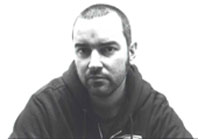
Biography
<p>Paul Whitty was born in Lisburn , Northern Ireland in 1970. His work has been performed by Tim Brady, Ensemble Cattrall, Jane Chapman, decibel, Ensemble Expose, Darragh Morgan & Mary Dullea, Michael Finnissy, Paul Goodey, Philip Howard, Mieko Kanno, IXION, London Sinfonietta, Kate Ryder, Noszferatu and [rout], and featured at BMIC's The Cutting Edge, Brighton Festival, Gaudeamus, ICA, Huddersfield Contemporary Music Festival, State Of The Nation, the Ultima Festival and Tate Britain . His work has found its way into spaces and contexts including the Mecca State Bingo Hall in Kilburn, Addenbrookes Hospital in Cambridge, the freezer compartment of a fridge in Romford, and the traffic gyratory at Vauxhall Cross.<br /><br />Paul has a particular interest in collaborative and cross-disciplinary practices. His ongoing collaborative project Vauxhall Pleasure (2004-2008) with Anna Best consisted of a site event at Vauxhall Cross, London ; an installation at the Museum of Garden History as part of their Tempered Ground exhibition; and two performances at Tate Britain . The latest phase of the project has been funded by the AHRC. In the introduction to the ACE publication Open Space: Art in the Public realm in London 1995-2005 Jemima Montagu comments:<br /><br />'Both socio-political protest and live art and music performance, this project captures the richly layered, interdisciplinary and ultimately uncategorisable nature of art in the public realm today.'<br /><br />More information at www.vauxhallpleasure.org.uk<br /><br />Paul is a founding member of [rout], an ensemble that he directs with composers Sam Hayden and Paul Newland. Recent projects include an appearance at the Night of the Unexpected at HCMF 2007. [rout] took up residence in a Warehouse at the industrial complex Bates Mill and performed a series of works including Paul's instruction score …i was bored before I even began… In this work contact microphones amplify the sound-making actions of the performers. These sounds are then transformed by signal processors; distortion; pitch-shift; hyper-metal; super-octave; digital delay. For the duration of [rout]'s performance, Paul's film installation watching Antoinette Vischer playing Gyorgy Ligeti's Continuum was projected.<br /><br />Paul is currently Reader in Composition and Director of the Sonic Art Research Unit at Oxford Brookes University.<br /><br />Links:<br />Vauxhall Pleasure: www.vauxhallpleasure.org<br />[rout]: www.routweb.com<br />Sonic Art Research Unit http://ah.brookes.ac.uk/saru</p>
<p><em>'Recently I have been engaged in a series of interventions in pre-existing contexts- re-reading, re-organising, re-categorising, re-distributing and re-sounding the materials that I have found there. These contexts can be scores, actual physical sites or instruments. In the violin and piano duo thirty-nine pages (2005-2007) I re-organised each page of the Henle Urtext Edition of Cesar Franck's Sonata for violin and piano in A Major. These works stem from an obsession with the provenance of musical materials. I have also intervened in physical sites such as Vauxhall Cross Gyratory as part of an ongoing collaboration with visual artist Anna Best; Vauxhall Pleasure (2004-2008). This project examines the gyratory's past as the Vauxhall Pleasure Gardens; and present as a monument to our ruinous car culture. Vauxhall Pleasure pits the songs of the pleasure gardens composer in residence- Thomas Arne- against the roar of the internal combustion engine.'</em></p>
<p>Paul Whitty</p>
<p>
<p><span style="font-size: small;"><span style="font-size: 13px;"><em>'From ten speakers at the back of the room the fluctuating rumble of traffic resembled the sound of the sea, while the singers' disembodied voices emerged like a siren's song beneath the growl of the engines'</em></span></span></p>
<p><span style="font-size: small;"><span style="font-size: 13px;">Holly Walsh; Frieze Magazine; on Vauxhall Pleasure.</span></span></p>
<p><span style="font-size: small;"><span style="font-size: 13px;">
<p><span style="font-size: small;"><span style="font-size: 13px;"><em>'The sheer audacity of the volume of Whitty's score and George's extended use of stillness…was subtle and extremely refreshing. '</em></span></span></p>
<p><span style="font-size: small;"><span style="font-size: 13px;">Martin Hargreaves, Dance Theatre Journal/2000 reviews 'on/off'</span></span></p>
</span></span></p>
</p>